Dogs, much like humans, have a natural inclination to stretch. This behaviour is not only a sign of comfort and relaxation but can also be an indicator of underlying health issues and more. Here is a quick overview of some of the common stretches we may see in our four-legged friends.
The Greeting Stretch
When your dog sees you after a long day, you might notice them stretching as they approach you. This is known as the “greeting stretch,” and it’s a sign of affection and comfort. The dog’s front legs are extended forward, their chest is close to the ground, and their rear end is raised. The dog’s ears are relaxed, and they have a soft, ‘welcoming look’ in their eyes. This stretch is a clear sign of your dog’s happiness and comfort around you.
Check out the example of a greeting stretch in this video with Chico the Rough Collie as he steps out of his soft crate and greets his owner.
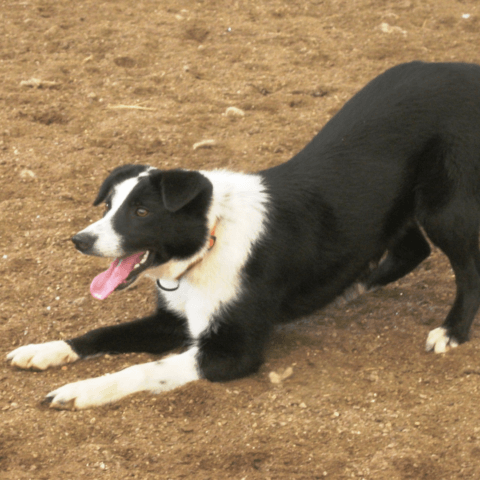
The Playful Stretch
Another common stretch in dogs is the “play bow.” This stretch is often seen when dogs are excited and ready to play.
The dog’s front legs are stretched out in front of them, elbows touching the ground, and the dog’s rear end is in the air. This stretch is a clear invitation to play and is a sign of a happy and energetic dog. In this image we have a dog waiting patiently for their ball to be thrown.
The Bounce – disguised as a Play Stretch/Bow
However, sometimes you might see a dog offer what may appear as a play stretch/bow when first encountering another dog but it is actually more of a ‘bounce’. This is a handy way to immediately create space from the other, when the dog wants to keep the interaction friendly yet wants to manoeuvre away swiftly for safety. This is what creates that bounce effect.
You can see an example of this in an old video of my Basset Hound, Howard and the interaction he has with Buzz the Shar Pei. Buzz is nervous around dogs having been attacked when young, in this video you see Buzz ‘bounce’ on three occasions in order to get away from Howard.
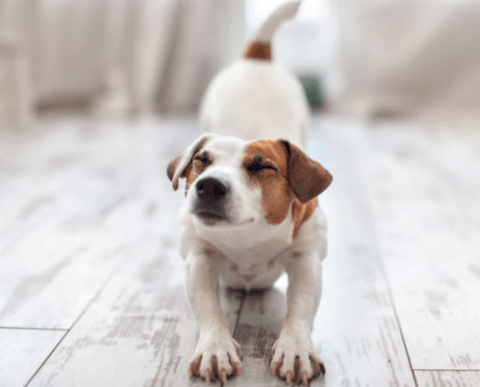
The Tired Stretch
Just like humans, dogs also stretch when they wake up from a nap or a long sleep. This is known as the “tired stretch.”
After laying in the same position for several minutes or hours, the muscles lose some tone and tighten, so stretching is an effective way to loosen them. This stretch is a normal part of a dog’s daily routine and is a sign of a well-rested dog.
The Pain Stretch
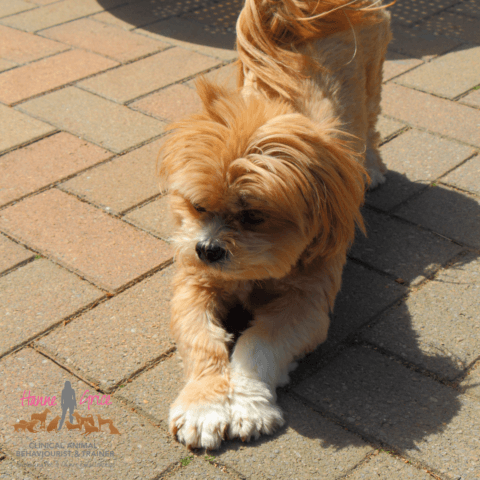
Sometimes, however, a dog’s stretch can indicate discomfort or pain. One such stretch is the “prayer position,” where the dog’s front legs and chest are on the ground, and its rear end is raised. This stretch can be a sign of abdominal pain or discomfort. If your dog is performing this stretch frequently, the dog might be suffering from a medical condition (e.g., pancreatitis, Giardia, bloating etc,). If you notice this behaviour, it’s important to consult with your veterinarian as soon as possible.
The Stretch as a Trick
We can teach our dogs to perform a stretch known as the ‘bow’ on verbal or visual cue. It also helps provide our dog with a great stretch as well as a cute party-trick.
Here is a snippet example of me mucking around with this behaviour with my rescue dog, Hattie. It isn’t an elegant bow as she is an old dog and I am not seeking perfection with this, however it is something we find great fun to do together.
Cautionary Stretch
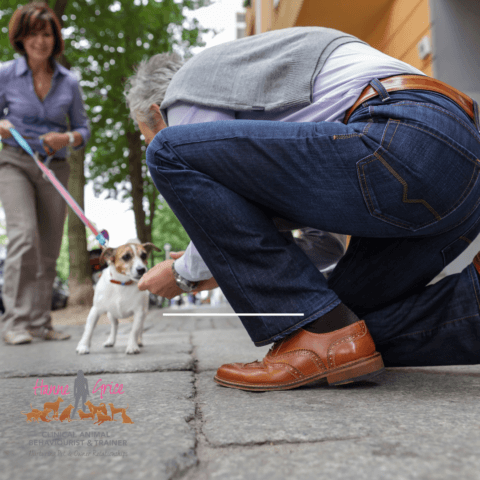
When a dog is cautious or uncertain, their stretching behaviour may reflect this emotional state. For instance, when a dog is offered a treat by an unfamiliar person, the dog might stretch their front end towards the treat while their rear end stays planted to the spot, appearing fairly rigid. This behaviour can be seen as a conflict of emotions. The dog is interested in the treat, hence the forward stretch, but is also wary of the unfamiliar person, hence the rigid rear end. This stretching behaviour is a nonverbal communication tool, where the dog is emotionally conflicted – showing both interest and caution at the same time. This is where we need to be careful to avoid overwhelming our pet where food is presented as a sort of lure to create an interaction/ get them to move towards the perceived ‘scary’ thing.
It’s important to note that dogs use body language as a primary form of communication. Understanding these subtle cues can help us better interact with our canine companions and respect their boundaries. If a dog shows signs of discomfort or unease, it’s crucial to give them space and allow them to approach at their own pace.
Key-takeaways
While stretching is a normal behaviour in dogs, it’s crucial to pay attention to the type and frequency of the stretches and the contexts in which they are occurring in order to determine the function the stretch is serving . Understanding the differences between these stretches can help you better understand your dog’s behaviour and health. How many of these stretches do you see with your dog?
Learn more about our classes
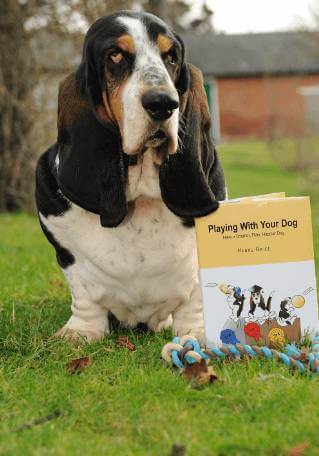
Get Hanne's book, clothing and more
Hanne has a number of publications including her book Playing With Your Dog to help owners work out the games that are best suited for their pet to play throughout his life, from puppyhood to old age, available from Amazon. Check out Hanne's range of contemporary casuals The Collection – for pet lovers made from recyclable, organic materials that are sustainably sourced.

